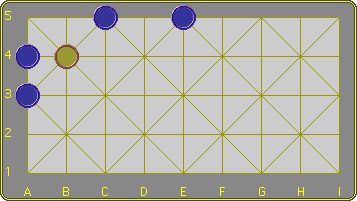 | Fanorona 'Contact Draughts' derives from the method of capture of Fanorona, the national game of Madagascar. Fanorona has three standard versions: Fanoron-Telo, Fanoron-Dimyand, and Fanoron-Tsivy, the difference being the size of board. Fanoron-Telo is played on a 3×3 board and the difficulty of this game can be compared to the game of tic-tac-toe. Fanoron-Dimyand is played on a 5×5 board and Fanoron-Tsivy is played on a 9×5 board. We will call Fanoron-Tsivy from now on Fanorona since it is the widest-known variant. |
Looking at the Fanorona board, it's hard to miss the Alquerque board. Like Checkers, the game has been solved.
However, the same game with a left-right initial position, instead of top-bottom, has not been solved.
Not much of its history is clear. Wiki reiterates a legendary story about King Ralambo (1575-1610) implying that the game was played during his reign.
The 'Online Guide to Traditional Games' gives the time of invention as being around 1680, but does not elaborate.
So history is a mystery, but someone obviously had the idea to capture with the first move in Alquerque, not with a jump, because there isn't one available on the first move, but by contact. Such an idea doesn't turn into a game by itself, so experiments with the new method of capture must have taken place, eventually solidifying in the rules and variations that currently exist. There are smaller variants, but we'll concentrate on the 9x5 version called Fanoron Tsivy and the most commonly used rules.
There's quite another way in which the game is unique: it is the mother of all forms of contact checkers, or karate checkers if you like, which to my knowledge amounts to precisely one other game, namely Bushka.
I have no idea why capturing a man by leapfrogging it has given rise to a whole class of games throughout the cultures of the world, whereas the at least as logical hitting it karatewise has only blossomed in Madagascar, at least till Bushka's arrival.
Rules
Fanorona is played on a board with a grid of 5x9 points connected with lines indicating valid movements as in the diagram.
There are two players: White and Red. Initially 22 pieces of each color are placed on the board as shown.
Object
The object of Fanorona is to capture all opponent's men.
Players move in turn, starting with White. There are two kind of moves: non-capturing (called paika) and capturing moves:
- A paika move consists of moving one piece to an adjacent point along any drawn line.
- A capturing move results in removing one or more pieces of the opponent. A capturing move is mandatory: if a player on his turn can capture some pieces of the opponent then he is obliged to do so.
There are two kind of capturing moves: by approach or by withdrawal.
- By approach - if a player moves one of his pieces along a line to an adjacent point and the next point on the same line is occupied by an opponent piece then the opponent piece is captured and all successive opponent pieces that lie in an unbroken row behind it on the same line are captured as well.
- By withdrawal - if a player moves one of his pieces along a line to an adjacent point and the previous point on the same line is occupied by an opponent piece then the opponent piece is captured and all successive opponent pieces that lie in an unbroken row behind it on the same line are captured as well.
- If a player makes an approach that is a withdrawal at the same time, he has to choose one or the other.
- The capturing piece is allowed (but is not obliged) to continue making successive captures, removing captured pieces after each single step. It can stop at each step, but making a step implies making the capture. Multiple capture is faced with the following restrictions:
- A capturing piece is not allowed to arrive at the same point twice during the same turn.
- It is not allowed to make two successive capturing steps in the same direction (the possibility can arise if an approach can be made following a withdrawal on the same line).
Draws are possible in Fanorona.
 The white man makes a multiple capture in four steps | Example
|
 Leading to this result |
External links
